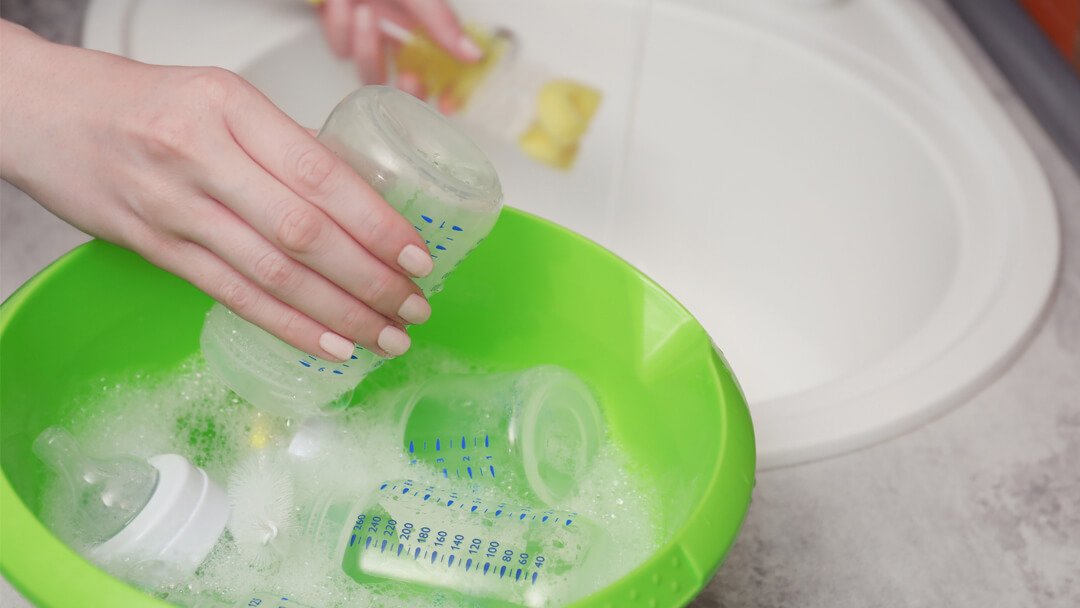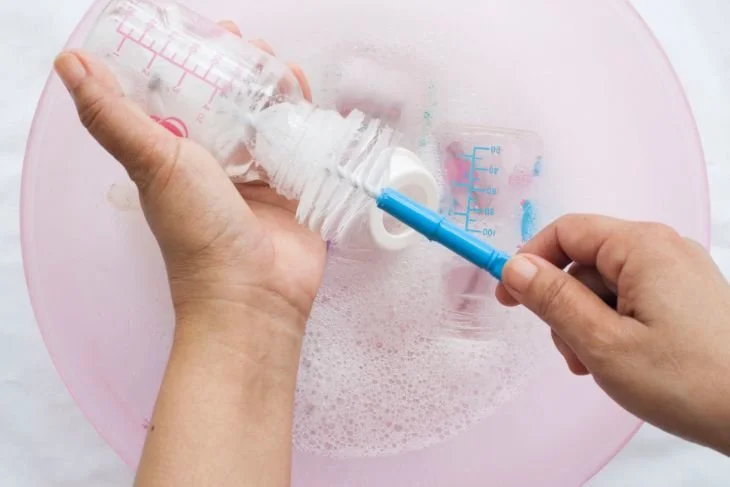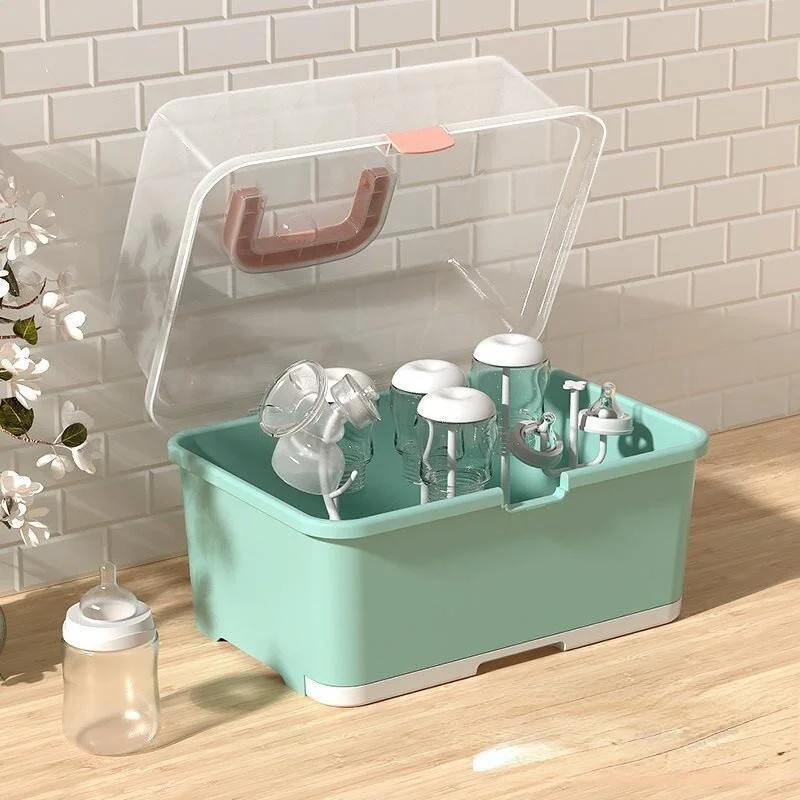How to Clean and Sanitize Baby Feeding Items
A Quick Guide for Parents
Discover > Healthy Living Through Food > How to Clean and Sanitize Baby Feeding Items
Cleaning and sanitizing baby feeding items is a crucial aspect of ensuring your little one's health and safety. Parents and caregivers need to pay close attention to the proper handling and care of baby's bottles, nipples, pacifiers, and other essential feeding equipment. Not only does this process help prevent the spread of germs and bacteria, but it also helps extend the life of these items, ensuring your baby receives optimal care.
Differentiating between cleaning and sanitizing is key. Cleaning removes food and dirt with soap and water while sanitizing takes it a step further by eliminating harmful microorganisms like bacteria and viruses. Combining both ensures a safe, germ-free environment for feeding your baby.
When it comes to ensuring the health of your little one, knowing how to clean and sanitize baby-feeding items like baby bottles and infant-feeding items is essential, it's important to properly sterilize baby bottles before each use. Sterilizing baby bottles properly is crucial to prevent harmful bacteria from contaminating breast milk or formula.
To clean baby bottles effectively, start by washing them with warm, soapy water. Then, use a dedicated baby bottle brush to scrub hard-to-reach spots. While sterilizing baby bottles is important during the early months, as your baby grows, you can gradually stop sterilizing baby bottles as long as you continue to clean infant feeding items thoroughly. This routine will help ensure the well-being of your baby and contribute to healthy babies all around.
Understanding the Need to Clean and Sanitize
Cleaning and sanitizing baby feeding items are essential steps towards ensuring good hygiene and maintaining a healthy environment for infants. This is because babies have delicate immune systems that are still developing; hence, they are more susceptible to infections caused by bacteria, viruses, and other germs.
Regular cleaning of feeding items helps to remove visible dirt, food residues, and debris. It is crucial to clean these items before sanitization since the process of sanitizing is significantly less effective if surfaces are not thoroughly cleaned beforehand.
Sanitizing, on the other hand, plays a vital role in reducing germs to a safe level. By employing sanitization methods, such as boiling or using chemical disinfectants, parents and caregivers can further protect infants from potential illnesses.
It is especially important to sanitize items like baby bottles, nipples, and pacifiers after each use, as these items come into close contact with the baby's mouth and can quickly harbor harmful microorganisms.
Ultimately, understanding the need to clean and sanitize baby feeding items is a crucial part of providing a safe and healthy environment for the little ones.
By incorporating these practices into a daily routine, parents and caregivers can help prevent infections, reduce the risk of illnesses, and ensure that babies receive the proper care they need.
Selection of Right Baby-Feeding Items
When it comes to choosing the right baby-feeding items, it's essential to consider both safety and convenience. To make the selection process easier, keep in mind the following factors:
Material:
Opt for baby-feeding items made from safe materials like BPA-free plastic, glass, or food-grade silicone. These materials are resistant to heat and do not pose any risk of toxic chemicals leaching into your baby's food.
Ease of Cleaning:
Choose items that are easy to clean and dishwasher-safe. This will ensure that you can thoroughly clean and sanitize them after each use. Items with fewer parts are generally easier to clean as well.
Size and Shape:
Consider the size and shape of the baby-feeding items. They should be appropriate for your baby's age and development. For example, smaller bottles and nipples are suitable for newborns, while larger bottles and variable-flow nipples are ideal for older infants.
Compatibility:
Ensure that all parts of the baby-feeding items, such as bottles, nipples, and accessories, are compatible with one another. This will help streamline the cleaning process and reduce the risk of mixing up parts from different brands or products.
When selecting baby-feeding items, consider the following types:
Bottles: Available in various materials like glass, plastic, and silicone, bottles come in different sizes and shapes to cater to your baby's needs.
Nipples: Offering different flow rates, nipples come in either silicone or latex options. It's best to choose silicone nipples since they are more durable and less likely to cause allergic reactions.
Bottle Accessories: Items such as bottle brushes, drying racks, and bottle warmers can help streamline the cleaning and preparation process for baby feeding.
By keeping these factors in mind, parents can confidently select baby-feeding items that are safe, convenient, and appropriate for their baby's needs.
Gathering Essential Cleaning and Sanitizing Supplies
To properly clean and sanitize baby feeding items, it's crucial to gather all the necessary supplies beforehand. Start by assembling the following items:
Mild dish soap ensures that your baby's feeding items are clean without leaving harsh chemical residues.
Soft-bristled bottle brush enables thorough cleaning of bottle interiors and other feeding items with hard-to-reach areas.
Clean dishcloth or sponge for general-purpose cleaning of larger surfaces such as high chairs and trays.
Tongs or a basket for lifting smaller items from boiling water or a sterilizer.
Distilled white vinegar can be used for routine sanitization and help remove limescale buildup from boiling water.
Having a dish drying rack is also essential for drying sanitized feeding items in an organized and hygienic manner. It allows the items to air dry, minimizing the risk of recontamination from contact with damp dishcloths or towels.
When it comes to sanitizing methods, you can choose from various options depending on your preference and the items' material. Ensure that the selected method is suitable for your baby's feeding items to prevent any damage. Here are three common sanitizing methods:
Boiling: Boil water in a large pot and submerge feeding items for at least 5 minutes. Use tongs or a basket to remove items and let them air dry on a clean dish rack.
Steam sterilizing: Electric steamers are designed specifically for sterilizing baby-feeding items. Follow the manufacturer's instructions for loading, operation, and duration.
Microwave steam bags: Many brands offer microwave-safe bags that steam-clean baby items. Be sure to read the instructions provided on the package for usage guidelines and duration.
Having the essential cleaning and sanitizing supplies on hand, choosing a suitable sanitization method, and storing items in a clean, dry place are critical steps to ensure the proper care of your baby's feeding items.
Pre-Cleaning Steps
Emptying Feeding Items
Before cleaning and sanitizing baby feeding items, it is crucial to empty any remaining contents from bottles, sippy cups, and other items that might have food or liquid inside. Pour out any leftover formula, milk, or food into the sink or a designated container for discarding waste.
Gently tap or shake the items to remove any stubborn contents that might be stuck inside. This initial step helps make the cleaning and sanitizing process more efficient by removing larger debris that could interfere with the proper cleaning of the items.
Rinsing Off Residue
Once the feeding items have been emptied, it is important to rinse off any remaining residue. Hold each item under warm running water, focusing on areas where food or liquid was in contact with the surface.
Be sure to thoroughly rinse the inside of bottles, the edges of sippy cups, and the surface of feeding spoons. Rinsing the residue immediately after use can help prevent the buildup of dried or hardened food, which can be more difficult to clean later.
After completing these two pre-cleaning steps, the baby feeding items are now ready for cleaning and sanitization. Following these guidelines ensures a more effective and efficient process, keeping your baby's feeding items safe and hygienic.
Deep Cleaning Process
Using Mild Soap
Start by creating a soapy mixture using one to two teaspoons of mild, fragrance-free dish soap and warm water. Submerge the baby feeding items into the solution and let them soak for a few minutes to loosen any remaining residue.
Scrubbing Feeding Items
Once the items have soaked, use a soft-bristled brush to scrub each piece thoroughly. Be sure to target small crevices and hard-to-reach areas of bottles, nipples, and other feeding accessories. The idea is to not only remove any visible residue but also eliminate unseen germs and bacteria that might have settled on the items.
Rinsing Thoroughly
After scrubbing, rinse each baby feeding item with hot water to remove any remaining soap and debris. It's essential to ensure that no soap residue is left behind, as it could cause discomfort or irritation for the baby during feeding. To be thorough, run items under hot water for at least 15 seconds, twisting and turning them to ensure every nook and cranny has been rinsed.
Disinfecting Feeding Items
Boiling Method
The boiling method is a simple and effective way to disinfect baby-feeding items. Fill a large pot with water, making sure there is enough to submerge all the items you need to sanitize. Bring the water to a rolling boil and carefully place the feeding items in the water. Allow them to boil for at least five minutes to ensure proper sanitization. Using tongs, carefully remove the items from the water and place them on a clean, dry surface to air dry.
Steam Sanitizing Method
Steam sanitizing is another great option for disinfecting baby-feeding items. There are steam sanitizing devices specifically designed for this purpose, or you can use a microwave or electric steam sterilizer. Follow the manufacturer's instructions for your chosen device.
Usually, this involves adding a small amount of water to the base and placing the feeding items inside. The items should be arranged so that the steam can easily reach all surfaces. Close the sterilizer and turn it on, letting it run for the recommended time. Once finished, let the items cool down and air dry on a clean surface.
Chemical Sanitizing Method
Chemical sanitizing is an alternative method that can be used when other options are not available. To use this method, you will need a sanitizing solution specifically designed for baby-feeding items. It is important to follow the manufacturer's instructions for the correct dilution and usage of the solution.
Typically, you will need to:
Fill a large basin or container with cool water and add the required amount of sanitizing solution.
Submerge the feeding items in the solution, ensuring they are fully covered.
Let the items soak in the solution for the recommended time, usually around 10-30 minutes.
Carefully remove the items using tongs, and rinse thoroughly under running water to remove any residual solution.
Place the items on a clean drying rack or surface to air dry.
Drying and Storing Baby-Feeding Items
After cleaning and sanitizing the baby-feeding items, it is crucial to ensure they are properly dried and stored to prevent contamination.
To do this, follow the steps below:
Air-drying: Place the clean items on a clean dish towel or drying rack. Make sure that the items are positioned in a way that allows air to circulate them. Allow them to air dry completely before storing.
Proper storage: Store the dried baby-feeding items in a clean, dry place. Utilize closed cabinets or containers with a lid to keep them protected from dust and airborne particles. Avoid placing items in moist or damp areas, as it may encourage bacterial growth.
Regular inspection: Regularly inspect baby-feeding items for any signs of wear or damage. Be on the lookout for cracks, chipped parts, or discolored components that could harbor bacteria. Replace damaged or worn items as needed.
Organizing items: It's important to keep baby-feeding items organized to maintain cleanliness and ensure easy access when needed. Assign separate storage areas for bottles, nipples, and other feeding accessories, and label them for easy identification.
Frequency of cleaning: Even in storage, baby-feeding items can accumulate dust or dirt over time. It is crucial to clean and sanitize items before each feeding session, and to clean storage areas regularly to maintain a hygienic environment for your baby.
By adhering to these guidelines for drying and storing baby-feeding items, parents can be confident in their ability to maintain a clean and safe feeding environment for their little ones.
This is the guide on DIY Essentials Oils: A Simplified Guide. Check this out.
Healthy Living Tips for Parents: Handling Milk. Check this out.
Take a look on Texas Real Food Guide on Baby Milk Handling.







